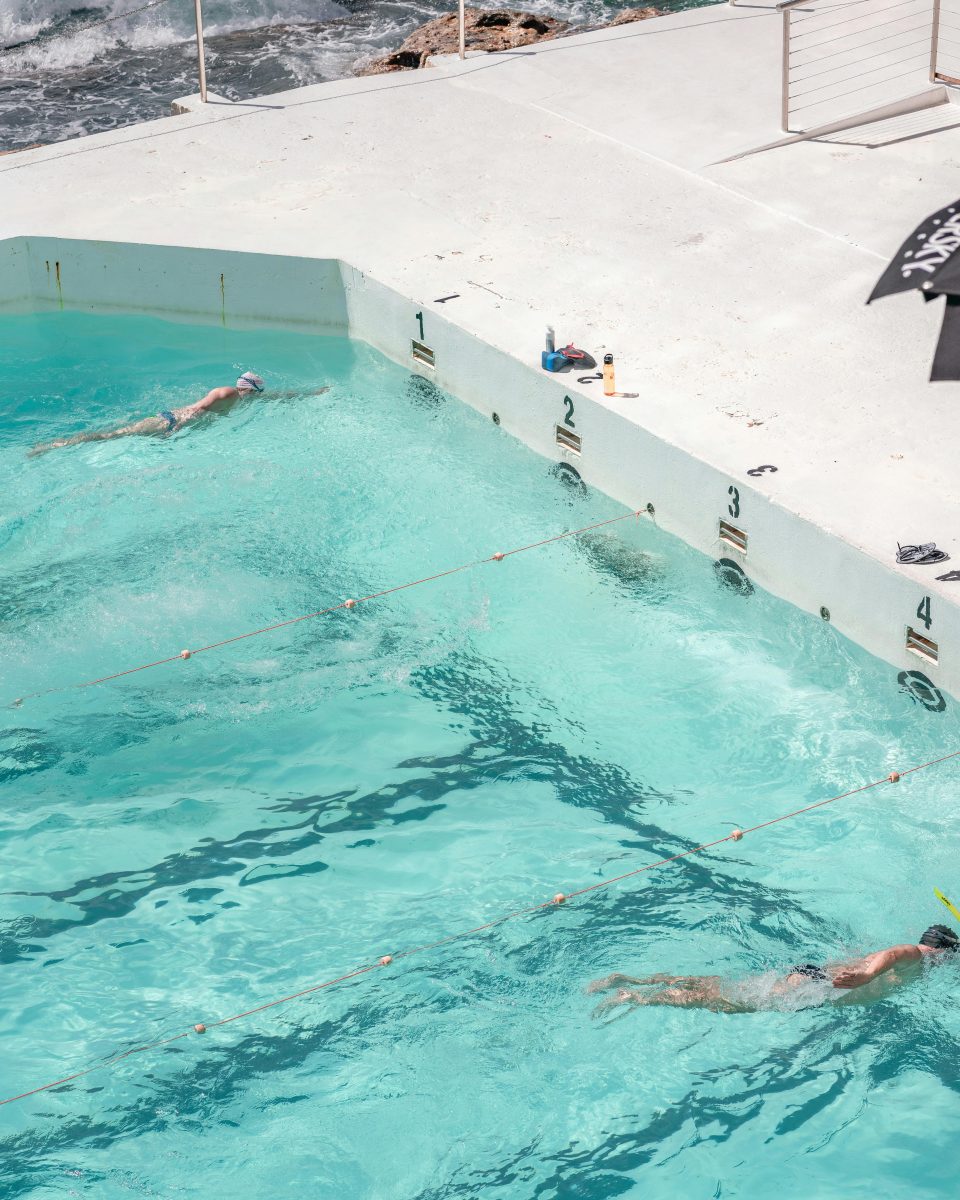Last Updated on: 14th July 2024, 09:07 am
Introduction to Swimming as an Exercise

Swimming stands out as a remarkable form of physical activity, tracing its roots back to ancient civilizations where it was not only a survival skill but also a method to maintain fitness. This age-old practice has evolved, embracing the unique benefits of water resistance, which sets it apart from other forms of exercise. Water’s natural resistance challenges every muscle group, making swimming an unparalleled full-body workout.
- Low-impact environment: Reduces the strain on joints and minimizes the risk of injury, making it suitable for all ages and fitness levels.
- Enhances muscle strength and endurance: Provides a cardiovascular workout, benefiting the heart and lungs.
- Refreshing variety: Introduces a refreshing variety to conventional workout routines.
Understanding the Full-Body Impact of Swimming

Muscles Targeted During Swimming
Swimming is a symphony of movement, engaging muscles from head to toe. The core stabilizes your body in water, while the arms and shoulders power through strokes, building strength and endurance. Legs and glutes kick into action, propelling you forward. This harmonious effort targets a wide array of muscle groups, including the back, abdominals, and even the muscles of the chest. Each stroke offers a unique challenge, ensuring a comprehensive workout that tones and sculpts the body.
Cardiovascular Benefits
The heart loves swimming. As you glide through the water, your heart rate increases, pumping oxygen-rich blood to those hard-working muscles. This cardiovascular workout strengthens the heart, improves circulation, and boosts lung function. Regular swimming sessions can lower blood pressure, reduce the risk of heart disease, and enhance overall heart health. It’s a workout that not only builds muscle but also fortifies your body’s engine.
Comparison with Other Forms of Exercise
- Low-impact, high-reward: Reduces stress on joints, making it ideal for injury prevention and recovery.
- Full-body engagement: Engages the entire body in a cohesive, fluid motion, unlike weightlifting which isolates specific muscle groups.
- Cooling effect: Makes swimming a refreshing experience, even as your body heats up from the effort.
Diving Deeper: The Benefits of Different Swimming Strokes

Freestyle: The Fast Track to Fitness
Freestyle is the go-to for speed and endurance. It’s a stroke that cuts through water, engaging your whole body in a rhythmic dance. Your arms slice forward, your legs kick vigorously, and your core tightens to keep you streamlined. This stroke boosts your heart rate, enhancing cardiovascular health and building endurance. It’s fast, it’s efficient, and it’s the perfect starting point for those looking to make waves in their fitness journey.
Breaststroke: The Path to Flexibility and Toning
Breaststroke stands out for its unique technique, offering a full-body workout that emphasizes muscle toning and flexibility. With each pull, glide, and kick, you engage your arms, legs, and core, sculpting your physique while improving joint mobility. It’s a slower stroke, but don’t let that fool you. The resistance of the water means your muscles work hard, toning and strengthening with every movement.
Backstroke: Aligning Body and Mind
Backstroke offers a different perspective, literally. Floating on your back, you use alternate arm strokes and a flutter kick to propel yourself. This stroke is a boon for posture, as it requires a straight spine and strong core to maintain balance and direction. It strengthens the back muscles, alleviates stress on the spine, and promotes core stability. Plus, the rhythmic motion and breathing pattern can have a meditative effect, calming the mind as you glide.
Butterfly: The Powerhouse Stroke
Butterfly is the stroke that demands the most from your body, but it also offers the greatest rewards. It’s a dynamic, powerful movement that engages the upper body, core, and legs. Your arms move in a circular motion, your legs perform a dolphin kick, and your core keeps everything in sync. This stroke builds upper body strength, enhances cardiovascular health, and burns calories at a high rate. It’s challenging, but mastering the butterfly stroke can make you feel unstoppable.
Incorporating Swimming into Your Fitness Routine

Getting Started: Choosing the Right Pool and Gear
Finding the perfect pool is your first step. Look for one that matches your needs, whether it’s for laps or leisure. Next, gear up with essentials: a comfortable swimsuit, goggles to protect your eyes, and a swim cap to keep your hair out of the way. These basics set the stage for a smooth swimming experience.
Creating a Balanced Swimming Workout Plan
A well-rounded plan alternates between different strokes to engage various muscle groups. Start with freestyle, known for its cardiovascular benefits, then switch to breaststroke or backstroke for muscle toning and flexibility. Incorporate intervals of intense swimming followed by periods of rest. This variation keeps your muscles guessing and your heart pumping, maximizing the workout’s effectiveness.
Tips for Beginners and How to Stay Motivated
- Begin with short distances: Gradually increase as your stamina improves.
- Master your technique: Efficiency in the water reduces fatigue.
- Set realistic goals: Celebrate when you achieve them.
- Mix up your routine: Swim with a buddy, or join a swim class to stay motivated.
Swimming is not just another exercise; it’s a journey towards a healthier, stronger you. With the right approach, it can be an enjoyable and rewarding part of your fitness routine. Dive in, the water’s fine, and the benefits are waiting.
Overcoming Common Challenges in Swimming

Dealing with Water Fear and Safety Concerns
For many, the journey into swimming begins with overcoming a fear of water. Start slow, familiarizing yourself with the water’s feel in a shallow area. Gradual exposure, combined with breathing exercises, can significantly reduce anxiety. Safety is paramount. Always swim in designated areas under lifeguard supervision and consider swimming lessons to build confidence and competence in the water.
Navigating Crowded Lanes and Etiquette
Swimming lanes can get crowded, but understanding pool etiquette makes for a smoother experience. Choose a lane that matches your speed, and if you need to pass someone, do so on the left. If someone wishes to pass you, pause at the wall to let them through. Communication and respect go a long way in ensuring a positive environment for all swimmers.
Addressing Common Swimming Injuries and Prevention
While swimming is low-impact, injuries can still occur, often due to overuse or improper technique. Shoulder and knee issues are common. To prevent these, focus on proper form and gradually increase your swimming intensity. Incorporating strength training and flexibility exercises into your routine can also help. If pain arises, rest and consult a professional to address the issue before it worsens.
Swimming, with its myriad of benefits, can sometimes present challenges. Yet, with the right approach, these hurdles can be overcome, paving the way for a rewarding and healthful journey through the waters. Whether it’s conquering the fear of water, learning to navigate crowded lanes, or preventing injuries, each step forward brings you closer to harnessing the full potential of swimming as a comprehensive workout.
The Mental Health Benefits of Swimming

Stress Reduction and the Calming Effect of Water
- Immersing in the tranquility of water, swimmers often experience a profound sense of calm. The rhythmic sound of water lapping against the pool edge acts as a natural stress reliever, akin to a soothing melody.
- As you float and move, the water cradles your body, creating a sensation of weightlessness that can significantly lower stress levels and foster a state of mental well-being.
Swimming as a Meditative Practice
- With each stroke and breath, swimming becomes a meditative practice. The focus on breathing and the steady, repetitive motions can help clear the mind, similar to the effects of mindfulness meditation.
- This meditative state not only enhances mental clarity but also contributes to a more balanced mood and a sense of inner peace.
The Role of Swimming in Improving Sleep and Reducing Anxiety
- Regular swimming sessions contribute to better sleep patterns, thanks to the physical exertion and the calming influence of water.
- The exercise helps regulate the body’s stress hormones, such as cortisol, promoting relaxation and making it easier to fall asleep.
- Additionally, the endorphins released during swimming act as natural anxiety reducers, helping to alleviate feelings of anxiety and fostering a more restful night’s sleep.
Swimming’s mental health benefits are as significant as its physical advantages. The water’s embrace offers a sanctuary from the day’s stresses, while the act of swimming can serve as a powerful tool for mental rejuvenation. As you incorporate swimming into your fitness routine, you’ll not only witness a transformation in your physical health but also in your mental and emotional resilience.
Beyond the Pool: Open Water Swimming and Competitive Swimming

Transitioning from Pool Swimming to Open Water
- Stepping into the open water is a thrilling leap from the controlled environment of a pool. The absence of lane lines and the presence of natural currents challenge your navigation skills and adaptability.
- Start with calm, short distances and gradually increase your exposure to different conditions. This transition not only tests your physical prowess but also sharpens your mental focus.
The Thrill and Challenges of Competitive Swimming
- Competitive swimming pushes you to the edge, testing your limits against the clock and your peers. It’s a world where milliseconds matter, and the rush of adrenaline is unmatched.
- Training becomes more intense, focusing on technique, speed, and endurance. The camaraderie among swimmers and the exhilaration of personal bests make every challenge worth it.
How to Get Involved in Swimming Competitions and Communities
- Joining a swim club is your gateway to the competitive swimming world. Clubs offer structured training programs, coaching, and entry into sanctioned meets.
- Beyond competition, swimming communities provide a supportive network, sharing tips, experiences, and encouragement. Social media platforms and local swim groups are also great places to connect with fellow swimming enthusiasts.
Whether you’re gliding through a serene lake or racing in a bustling pool, swimming offers a unique blend of physical challenge and mental relaxation. The journey from pool swimming to open water and competitive arenas is a testament to swimming’s versatility as a full-body workout and a lifelong sport. Dive in, the adventure awaits.
In Closing
Swimming transforms fitness into a holistic journey. It’s an exercise that marries physical vigor with mental serenity, offering a unique blend of challenges and rewards. Through the rhythmic dance of strokes and breaths, swimmers embark on a path that not only sculpts the body but also calms the mind, fostering resilience and joy. This article has navigated the multifaceted world of swimming, from its full-body benefits to its mental health advantages, underscoring the sport’s unparalleled capacity to rejuvenate and strengthen. Embrace the water’s embrace, and let the journey of swimming propel you towards a healthier, more harmonious life.
Swimming as a Full-Body Workout FAQs
While swimming is generally safe, there are risks such as the potential for drowning, especially for inexperienced swimmers, and the risk of overuse injuries from repetitive motions. Proper supervision, learning swimming techniques, and gradually increasing intensity can mitigate these risks. It’s also important to be mindful of water quality to avoid infections or exposure to harmful substances.
Swimming can significantly aid in weight loss as it is a high-calorie-burning exercise. It engages the whole body, which means it burns a lot of calories in a short amount of time, making it an efficient way to lose weight. Additionally, the buoyancy of water reduces stress on joints, making it easier to exercise longer and more frequently.
Yes, swimming can improve flexibility since it involves a wide range of motion that helps stretch and lengthen the muscles. The buoyancy of water supports the body, allowing for greater ease in performing stretches and movements that might be difficult on land. Over time, this can lead to improved flexibility in the joints and muscles.
Swimming has been shown to benefit mental health by reducing stress, anxiety, and depression. The rhythmic nature of swimming and the soothing effect of being in water can produce a meditative state, promoting relaxation and well-being. Regular swimming sessions can also boost mood through the release of endorphins, known as the body’s natural feel-good hormones.
Swimming burns calories at a comparable rate to running, depending on the intensity and stroke used. While calorie burn can vary widely, vigorous swimming can burn as many or more calories than running without the high-impact stress on the body’s joints. This makes swimming a suitable alternative for those seeking an effective calorie-burning exercise with lower risk of injury.
For optimal fitness benefits, swimming 3 to 5 times a week is recommended. Consistency is key to building endurance and muscle, as well as improving cardiovascular health. Varying your swimming routines and intensity can also help prevent plateaus and maintain interest.
Swimming is an excellent option for cross-training because it provides a low-impact, high-resistance workout that complements high-impact exercises like running and weightlifting. It helps improve overall fitness, reduces the risk of injury by balancing muscle use, and aids in recovery by loosening tight muscles. Incorporating swimming into a cross-training routine can enhance athletic performance and prevent overuse injuries.
Yes, swimming is excellent for building muscle as it provides a full-body workout that targets multiple muscle groups simultaneously. The resistance of the water makes your body work harder, leading to muscle strengthening and toning. Different strokes focus on different muscles, allowing for a balanced workout.
Swimming improves cardiovascular health by strengthening the heart and lungs. Regular swimming increases the efficiency of your cardiovascular system, allowing for better oxygen distribution throughout your body. This can lead to lower blood pressure, improved endurance, and a reduced risk of heart-related diseases.
The butterfly stroke provides the best full-body workout as it requires coordination and strength from the arms, legs, and core to perform properly. This stroke engages the upper body, lower body, and core muscles more intensely than other strokes, leading to greater muscle development and cardiovascular benefits. However, it is also the most challenging to master, so incorporating a variety of strokes can offer a balanced workout.
Orlando is a all round athlete from Australia, now resident in Germany. His sports of passion of American Football(Offensive line), weight training and indoor rock climbing where he uses his 195cm wing span to his advantage.



